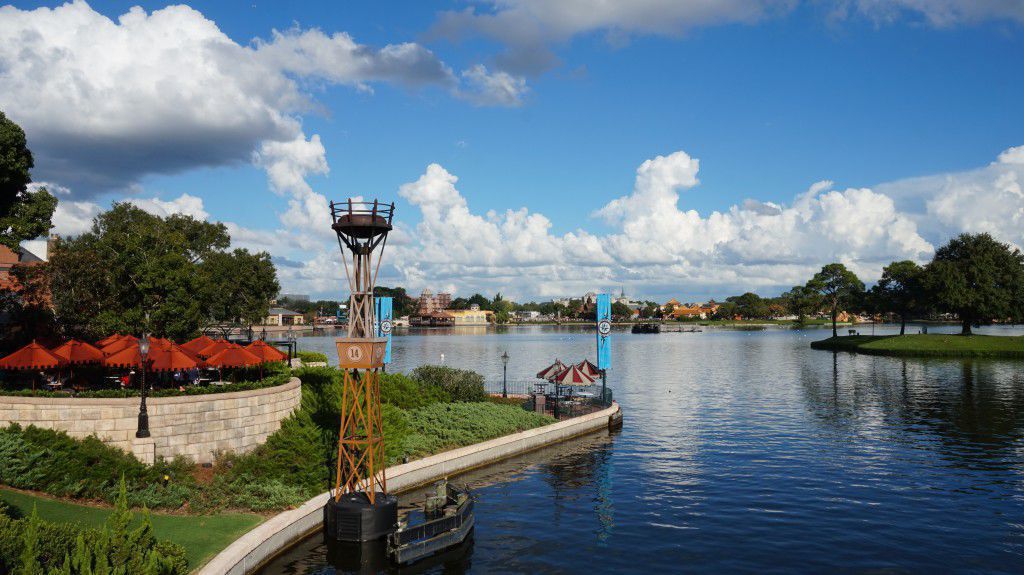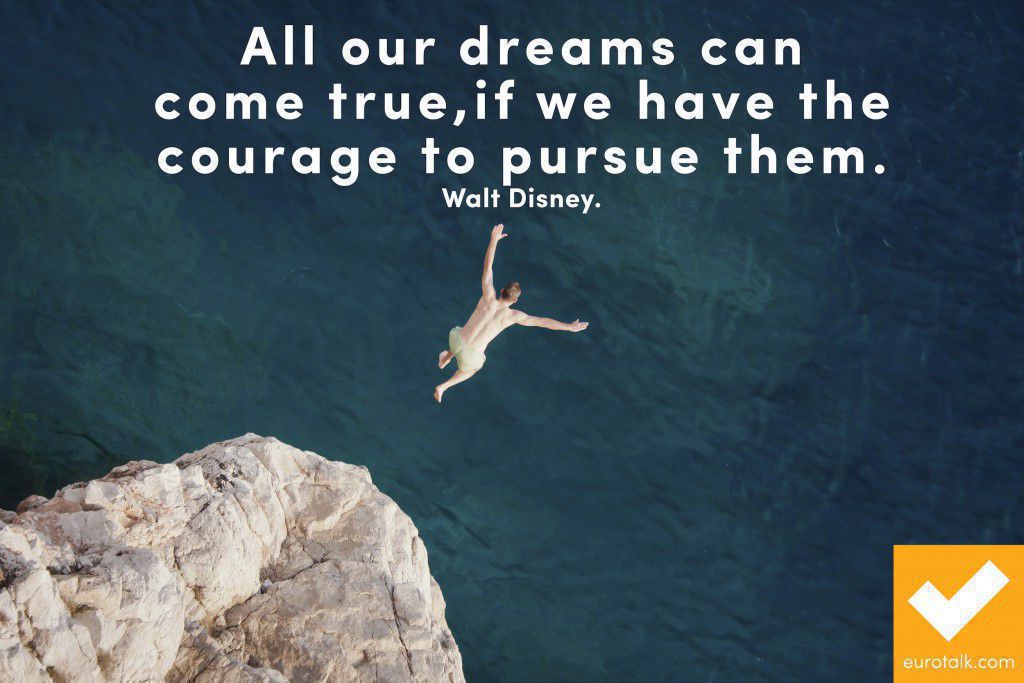Quote of the week: 30 Aug 2015
“All our dreams can come true, if we have the courage to pursue them.” Walt Disney
Embed This Image On Your Site (copy code below):
The power of song in language learning
Everyone has individual tips and specific techniques on how to learn a language quickly and effectively, ranging from immersing yourself in the culture of the language to listening to hours of vocabulary when asleep. During my final year of secondary school I had to learn French, to a very high standard, in around six months, so was more than willing to try any tip that people provided, however ridiculous they initially sounded. One of the most successful of these recommendations was listening to familiar songs in French. This began with Disney songs, including those from The Lion King and The Little Mermaid, and then later transitioned into pop songs ranging from Bruno Mars to Celine Dion.
 The key to this method of learning is being familiar with the lyrics, and subsequently being able to attribute each lyric you hear to the corresponding line in English. Whilst instant translation can normally be a struggle, the tune and the story told through the song aid a learner’s ability to translate much more quickly, and eventually remove the need to translate at all. By the time the song has been played for the fifth or sixth time, the language becomes familiar and instinctively understood. Listening to The Lion King on repeat for an hour, as instructed by my French teacher, means that I will never forget the word for ‘king’ in French.
The key to this method of learning is being familiar with the lyrics, and subsequently being able to attribute each lyric you hear to the corresponding line in English. Whilst instant translation can normally be a struggle, the tune and the story told through the song aid a learner’s ability to translate much more quickly, and eventually remove the need to translate at all. By the time the song has been played for the fifth or sixth time, the language becomes familiar and instinctively understood. Listening to The Lion King on repeat for an hour, as instructed by my French teacher, means that I will never forget the word for ‘king’ in French.
When learners become slightly more confident in their language, it is a great step to listen to a few songs which were originally written in the language being learnt. Obviously even the complete beginner is welcome to listen to native songs, but it can seem very overwhelming at first. Songs tend to move a lot quicker than normal conversation, and so it’s very easy to get lost in the speed of the lyrics and not take a lot in. However perseverance, as with any aspect of language learning, is key. Find a song that is relatable and enjoyable and listen to it a few times. If necessary the English translations for pretty much every song are available somewhere on the internet, and can help the initial process along. This process is how I discovered a genuine passion for French jazz, led by the multilingual Ben L’oncle Soul.
Have you incorporated songs into your language learning, or even discovered a passion for songs in another language? Let us know!
Kirsty
—
Want to join our blogging team? Email liz@eurotalk.com to find out more.
The true meaning of character names from fiction
The other day, I was watching one of my favourite films, The Lion King (yes, I know it’s a kids’ film but I love it) and I was reminded of a fun fact I read recently, that many of the characters’ names are taken from Swahili. Simba means ‘lion’, Rafiki means ‘friend’, ‘Nala’ means ‘gift’ and Pumbaa means ‘simpleton’. Poor Pumbaa.
So often when we watch a film or read a book, we take for granted that the characters are just called whatever they’re called, without considering why. So here are a few more examples – some of which may be surprising, but all of which I hope will be interesting.
Disney
The Lion King isn’t the only Disney film to give its characters significant names. In Beauty and the Beast, perhaps most obviously, the heroine’s name, Belle, means ‘beautiful’ in French. But many of the other characters resemble their names somehow, like Mrs Potts (the teapot), Cogsworth (the clock) and everyone’s favourite candelabra, Lumière, which means ‘light’.
In Sleeping Beauty, the name of the villain Maleficent comes from the Latin ‘maleficus’, meaning ‘wicked, prone to evil’. Seems appropriate. And on a similar theme, Cruella DeVille from 101 Dalmatians is pretty self-explanatory.
The Jungle Book
I think Rudyard Kipling would object to me listing this under Disney, although that might be where many people know The Jungle Book from. Shere Khan translates roughly as ‘Tiger King‘ (‘shir’ is ‘tiger’ – or ‘lion’ – in Persian, Punjabi and Hindi, while ‘khan’ is ‘king’ in many languages). ‘Bhalu’ (Baloo) means ‘bear’ in Hindi, and the ‘bagh’ in ‘Bagheera’ means ‘tiger’ – which is slightly confusing since Bagheera’s a panther.
Lord of the Rings
In J.R.R. Tolkien’s trilogy, the character Frodo Baggins gets his first name from the Old English word ‘fród‘, which means ‘wise by experience’.
Game of Thrones
The character names in George R.R. Martin’s books, and the accompanying TV series, for the most part seem to be modern names with a slight twist (Robb, Jaime, Eddard), but there is one character whose name has a deeper meaning – Bran Stark, whose first name is Irish for ‘raven‘. Fans of the series will know about the three-eyed raven, who plays a significant role in Bran’s story from the start.
Star Trek
I’m not much of a Star Trek fan myself, but I have it on good authority that Nyota Uhura’s name means ‘Star Freedom’ in Swahili.
Harry Potter
Many of the characters in J.K. Rowling’s best-selling series have names that mean something, most often in French or Latin. Voldemort (I’m not scared to say it!) means ‘flight from death’, which is very appropriate for a character whose main goal is immortality.
Meanwhile, the Malfoys’ surname means ‘bad faith’ in French, and perhaps the best known, because his name is a spoiler in itself – Remus Lupin, whose surname comes from ‘lupus’, which is Latin for ‘wolf’. His first name is also a reference to the story of Romulus and Remus, who were raised by wolves.
Star Wars
Speaking of spoilers – according to George Lucas, ‘Darth’ is a variation of ‘dark’ and ‘Vader’ is Dutch for ‘father’. So I guess the Dutch probably saw the big twist coming a mile off.
The Hunger Games
We’re told that Katniss Everdeen, the main character in Suzanne Collins’ books, was named for a plant, but there’s a bit more to it than that. The katniss plant is also known as ‘arrowhead’ and comes from the genus Sagittaria. Sagittarius – the archer. Katniss is pretty good with a bow and arrow. See how we got there?
So next time you’re enjoying your favourite movie or book, have a think about the character names, because they may have been the result of hours of debate!
Has anyone got any more examples?
Liz
Disney’s Frozen – how to find a voice that fits
‘How are we going to do that in 41 languages?’
This was the question that Rick Dempsey, senior vice president of Creative Disney Characters Voices International, asked himself when he first heard the ice queen’s song in the new Disney movie Frozen.
Dempsey has the incredibly interesting (if you’re a language geek, like me) job of finding foreign language voice artists for the localised international versions of the movie. As the market for films, TV shows and games has become ever more global, companies like Disney are having to move fast in producing translated versions of their films. No simple task, considering the entire film must not only be translated, but also adapted to the culture of another country.
And, especially with a Disney film, the voices are incredibly important. Idina Menzel, who sings the original English-language songs, has a powerful, rich and warm voice. Part of Dempsey’s job is to find a singer with similar qualities to the actor’s voice in each country. Not only that, but the translations of the songs must be tailored as closely as possible to the animation. If you ever watch dubbed movies in another language you speak, you may notice that what the voice artists are saying doesn’t match up with the English subtitles… This is because subtitlers often have to change, adapt and tailor the language to match up with the actors’ (or animations’) lip movements, body language and what’s on screen at the time.
Watching the multilingual version of ‘Let it Go’, you can see how fantastically both the voices and the words have been matched up with the original animation, and how the singers have been picked to match the character and to sound as similar as possible to the English voice.
Nat and I often have the similar (but on a much smaller scale!) task of picking foreign voice artists for our apps, including Maths and uTalk. Picking someone for the task isn’t a simple matter of whose voice sounds good – although this is important! We also have to check that each voiceover artist’s accent is appropriate for the target country (i.e. not a regional accent, or that they don’t pronounce any words in a non-native or non-RP way), that the voice sounds natural and native to a speaker of the language (some people who have been in the UK for a long time may have slightly lost their native accent), and that the voice suits the product. For Maths, we look for warm, friendly and young voices with plenty of enthusiasm. For uTalk, clear pronounciation and a neutral accent are most important.
So, I’m definitely keeping my eye out for a job with Disney on localising their next movie!
Alex




